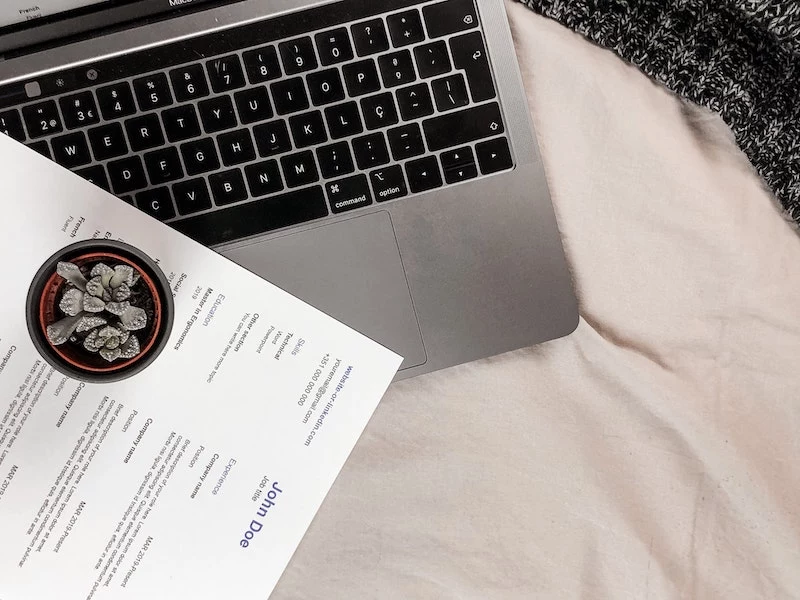Your Resume Isn’t Getting Noticed? This Might Be Why.
I’ve spent more time looking at resumes than I care to admit. From recent grads to seasoned execs, and folks making a complete career pivot, one thing is always true: writing about yourself is just plain hard. It feels awkward to brag about your wins, and the so-called “rules” seem to change every other week. So many people feel like they’re just tossing their applications into a black hole, never to be heard from again.
In this article
If that sounds painfully familiar, trust me, you’re not alone. The frustration is completely valid. But I can tell you from experience that building a powerful resume is a skill, not a secret. It’s not about finding some magic trick or using a ridiculously flashy template. It’s all about clear communication.
Your resume actually has two jobs. First, it needs to get past a piece of software. Then, it has to impress a very busy human. Nailing both is the real key to finally getting those interview calls.

I’ve sat with hiring managers and HR pros and seen what works from their side of the table. So, let’s break down the method I use with my own clients to build a resume that truly shows your value.
Understanding the Game: The Robot and the Recruiter
Before you even think about writing, you have to know your audience. And spoiler alert: it’s not just a person in HR anymore. Your first reader is a robot, and your second is a human with the attention span of a goldfish.
First Hurdle: The Applicant Tracking System (ATS)
Most companies these days use something called an Applicant Tracking System, or ATS. Just think of it as a bouncer for resumes. When a company gets 300 applications for one open role, the ATS is how they sort through the chaos. It scans your resume for keywords and phrases from the job description. If your resume doesn’t have the right stuff, a human being will probably never even see it.

It’s basically just simple text analysis. The software breaks your resume down into categories—contact info, work history, skills, etc.—and then gives it a score. This is exactly why tailoring your resume for each job isn’t just a suggestion; it’s mandatory.
But these systems are far from perfect. Oh yeah, I’ve seen them fail spectacularly. I once had a client, an incredible graphic designer, whose beautiful, visually stunning resume got zero calls. Turns out, he’d put all his key skills in a slick-looking sidebar. The ATS couldn’t read the columns correctly and just saw gibberish. We moved the exact same text into a simple, single-column list, and he landed three interviews the following week.
Heads up! ATS bots get easily confused by a few common things:
- Columns & Tables: An ATS reads left to right, top to bottom. If you use columns, it will read straight across the page, turning your carefully crafted resume into a jumbled mess. Stick to a single-column format.
- Graphics & Logos: Images, charts, and personal logos are often invisible or show up as errors. Keep your design clean and completely text-based.
- Fancy Fonts: Stick to the basics like Calibri, Arial, Georgia, or Helvetica. That cool script font might look great to you, but the machine might not be able to read it.
- Header & Footer Info: Some systems are programmed to skip the header and footer of a document. It’s a gamble. To be safe, put your name and contact info right at the top of the main body of the page.

Second Hurdle: The Six-Second Human Scan
Okay, so you made it past the robot. Congrats! Now your resume is in front of a real person. And studies show that person will spend, on average, about six seconds on their first look. That’s it.
It’s not because they’re lazy. They have a mountain of resumes to get through and have trained themselves to spot key info at a glance. They tend to scan in an “F-shaped” pattern: across the top, down the left side, and then another quick scan across the middle. This means the top third and the left margin of your resume are prime real estate.
To pass this human scan, your resume needs to be:
- A breeze to read: Use clear headings, bullet points, and lots of white space. A dense wall of text is an instant turn-off.
- Logically organized: Put information where they expect to find it. Contact info at the top, a punchy summary next, then your work experience.
- Focused on results: They don’t just want to know what you did; they want to know what you accomplished. Numbers and specific outcomes are what will make their eyes stop scanning.

The Pro Method: Building Your Resume Step-by-Step
A great resume isn’t written; it’s built. This is a deliberate process designed to take the guesswork out of it and get you real results.
Step 1: Create a “Master Resume”
One of the biggest time-wasters is trying to edit your resume from scratch for every single application. Don’t do that. Instead, create a “Master Resume.”
This is a private document, just for you. It can be five pages long, who cares! In it, you’ll list everything you’ve ever done. For each job, document your title, a few sentences about the company, and then create a massive brain dump of every project, problem solved, and responsibility you had. Dig for numbers: How many people did you manage? By what percentage did you increase sales? How much time or money did you save? List any awards or promotions.
Seriously, plan to set aside a full afternoon for this. It’s an investment that will save you hours of panic-editing later. This document is your personal career database.

Step 2: Become an Expert on the Job Description
Now, for the job you actually want. Print out the job description and grab a highlighter. You’re a detective looking for clues:
- Keywords: What specific skills, software, and qualifications are they asking for? If they say “project management” and “Asana,” those words better be on your resume.
- Responsibilities: What are the main duties? This tells you what the company’s biggest pain points are.
- Company Lingo: How do they talk? Are they all about “synergy” and “innovation,” or more about “efficiency” and “streamlining”? Using their language makes you sound like a good fit.
Pull out the top 5-10 keywords and requirements. This is your checklist for tailoring your resume.
Step 3: Write a Professional Summary That Hooks Them
Remember that six-second scan? The professional summary is your make-or-break moment. It’s a short, 3-4 line paragraph at the very top of your resume, right under your name and contact info. Its only job is to convince the recruiter to keep reading.

A simple formula works wonders: Start with your professional title and years of experience, mention 2-3 key areas of expertise (pulled from the job description!), and end with a major accomplishment. It could look something like this:
“Results-driven Marketing Manager with 8+ years of experience in digital strategy and brand development. Specializing in leading successful B2B campaigns and managing cross-functional teams. Proven ability to increase lead generation by over 200% through targeted content marketing initiatives.”
Step 4: Craft Bullet Points That Show Your Impact
The experience section is the heart of your resume. This is where you prove you can do the job. The key is to stop listing duties and start showcasing accomplishments. I teach my clients a simple formula: Problem, Action, Result (PAR).
For each bullet point, you’re telling a tiny story: What was the situation? What did you do about it? And what was the awesome result?
- Instead of: Responsible for managing social media accounts.
- Try: Grew Instagram followers by 40% in one year by developing and executing a new content strategy focused on user-generated content.
- Instead of: Handled customer service calls.
- Try: Resolved an average of 50 customer inquiries per day, consistently maintaining a 95% customer satisfaction rating.
But what if my job doesn’t have obvious numbers? This is a super common problem for teachers, admins, and creatives. Don’t worry, you have metrics too, they’re just different. Think in terms of scale, efficiency, or improvements.
- For an admin: Instead of “Organized office files,” try “Implemented a new digital filing system using Google Drive that reduced document retrieval time by 30% for a 20-person team.”
- For a teacher: Instead of “Taught 9th-grade history,” try “Developed a new interactive curriculum for 9th-grade history that was adopted by all 5 history teachers and led to a 15% improvement in standardized test scores.”
Formatting, Tools, and Final Touches
Good formatting isn’t just about looking pretty; it’s about making your resume easy to scan and digest.
The Rules of Readability
Let’s keep this simple. Follow these guidelines and you’ll be in great shape.
- Length: One page is the gold standard. If you have 15+ years of highly relevant experience, two pages is acceptable. Never more. For my executive clients with long careers, we use a two-page resume but make absolutely sure the first page has a powerful summary and their most critical recent accomplishments.
- Margins & Font: Keep margins between 0.7 and 1 inch. For the font, stick to something clean like Calibri or Arial, between 10-12 points.
- File Type: ALWAYS send your resume as a PDF. It locks the formatting so it looks the same everywhere. The only exception is if the application portal explicitly asks for a Word file.
Quick Win for Today: Open your current resume right now. Change the file type to PDF. Check that your margins are at least 0.7 inches all around. Boom. You just solved two of the most common formatting errors in less than a minute.
Your Free Resume Toolkit
You don’t need to spend money to get this right. Honestly, the best templates are often the simplest.
- Templates: Google Docs has a handful of excellent, free, ATS-friendly templates. Just search “resume template” when you open a new doc. A word of caution on sites like Canva: while some templates are great, avoid any that use graphics, photos, or complex column layouts.
- ATS Scanners: Want to see how the robots see your resume? Do a quick search for a “free resume ATS checker.” There are several sites that will let you upload your resume and give you a free report. It’s a great way to spot problems.
DIY or Hire a Pro?
So, should you do this yourself or pay someone? To be frank, you can absolutely do this yourself. If you’re willing to put in the time—a few dedicated afternoons, at least—and follow the advice here, you can create a fantastic resume.
So when does it make sense to hire a professional? I’d say it’s worth considering if you’re making a major career change, aiming for a very senior or executive role, or if you’re just so stuck that the frustration is costing you time and opportunities. A good coach or writer can cost anywhere from $300 to over $2,000, depending on your career level. It’s an investment, so it’s most valuable when the stakes are high.
At the end of the day, getting your resume right is about shifting your perspective. You’re not just listing a history of jobs. You’re building a strategic marketing document designed to solve a company’s problem. And you are the solution. Now go get that interview.










